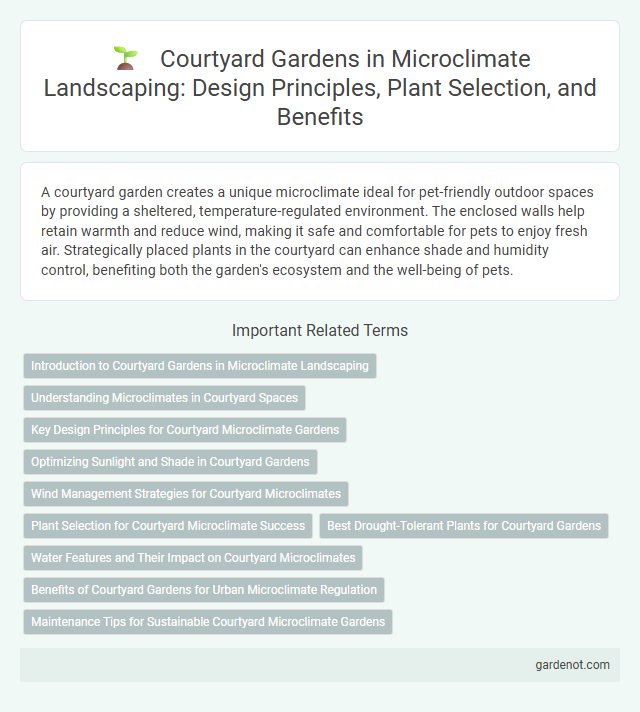A courtyard garden creates a unique microclimate ideal for pet-friendly outdoor spaces by providing a sheltered, temperature-regulated environment. The enclosed walls help retain warmth and reduce wind, making it safe and comfortable for pets to enjoy fresh air. Strategically placed plants in the courtyard can enhance shade and humidity control, benefiting both the garden's ecosystem and the well-being of pets.
Introduction to Courtyard Gardens in Microclimate Landscaping
Courtyard gardens create personalized outdoor spaces by leveraging microclimate principles that optimize sunlight, wind, and moisture conditions. These enclosed gardens often feature walls or buildings that regulate temperature and humidity, fostering ideal environments for diverse plant species. Incorporating elements like shade trees and water features enhances microclimate control, promoting comfortable and sustainable garden experiences.
Understanding Microclimates in Courtyard Spaces
Courtyard gardens create distinct microclimates through their enclosed design, which moderates temperature, reduces wind exposure, and retains moisture. Understanding factors like sun exposure, wall materials, and airflow patterns helps optimize plant selection and placement, ensuring healthy growth and comfort. Tailoring microclimate conditions promotes biodiversity and enhances the overall garden sustainability in courtyard environments.
Key Design Principles for Courtyard Microclimate Gardens
Courtyard microclimate gardens prioritize strategic placement of plants and hardscape elements to optimize sun exposure and wind protection, creating a balanced microenvironment. Incorporating thermal mass materials like stone or brick helps regulate temperature fluctuations by absorbing heat during the day and releasing it at night. Utilizing vertical layers of vegetation enhances airflow and moisture retention, promoting a comfortable and sustainable outdoor space.
Optimizing Sunlight and Shade in Courtyard Gardens
Optimizing sunlight and shade in courtyard gardens involves strategic plant placement and structural elements to create a balanced microclimate. Using deciduous trees or pergolas with climbing plants allows for seasonal modulation of sunlight, providing shade during summer and light penetration in winter. Incorporating reflective surfaces and light-colored materials enhances natural light distribution, promoting healthy plant growth and comfortable outdoor spaces.
Wind Management Strategies for Courtyard Microclimates
Courtyard gardens benefit from strategic wind management techniques such as installing windbreaks, using dense shrubbery, and incorporating tall, permeable fencing to reduce strong gusts and promote air circulation. Creating varied plant heights and layering vegetation enhances wind filtering while maintaining a balanced microclimate conducive to plant health. Effective wind management in courtyard microclimates prevents soil erosion, reduces moisture loss, and supports a stable growing environment.
Plant Selection for Courtyard Microclimate Success
Selecting appropriate plant species for a courtyard garden significantly enhances microclimate regulation by improving shade, humidity, and wind protection. Utilize drought-tolerant succulents and native shrubs to conserve water while incorporating broadleaf evergreens and vines to maximize cooling through transpiration. Prioritize plants with varying heights and foliage densities to create layered microhabitats that stabilize temperature fluctuations and promote biodiversity.
Best Drought-Tolerant Plants for Courtyard Gardens
Succulents like Agave and Aloe Vera thrive in courtyard gardens due to their exceptional drought tolerance and low water requirements. Lavender and Rosemary not only add fragrant aroma but also withstand dry conditions effectively, enhancing microclimate comfort. Incorporating native plants such as Yucca and Sage ensures sustainability and resilience in drought-prone courtyard microclimates.
Water Features and Their Impact on Courtyard Microclimates
Water features in courtyard gardens significantly influence microclimate by increasing humidity and promoting natural cooling through evaporation. Reflecting pools, fountains, and small ponds moderate temperature extremes, creating a more comfortable environment for plants and visitors. These features enhance air circulation and contribute to noise reduction, improving overall courtyard ambiance.
Benefits of Courtyard Gardens for Urban Microclimate Regulation
Courtyard gardens enhance urban microclimate regulation by reducing ambient temperatures through increased shade and evapotranspiration. These green spaces improve air quality by filtering pollutants and promoting natural ventilation within dense city environments. Their design supports biodiversity and mitigates urban heat island effects, contributing to more sustainable and comfortable urban living conditions.
Maintenance Tips for Sustainable Courtyard Microclimate Gardens
Consistent irrigation using drip systems minimizes water waste and supports plant health in courtyard microclimate gardens. Regular pruning promotes air circulation, reducing humidity and preventing fungal growth in enclosed spaces. Incorporating native, drought-tolerant plants enhances sustainability by adapting to local climate conditions and reducing resource input.
Courtyard garden Infographic

 gardenot.com
gardenot.com